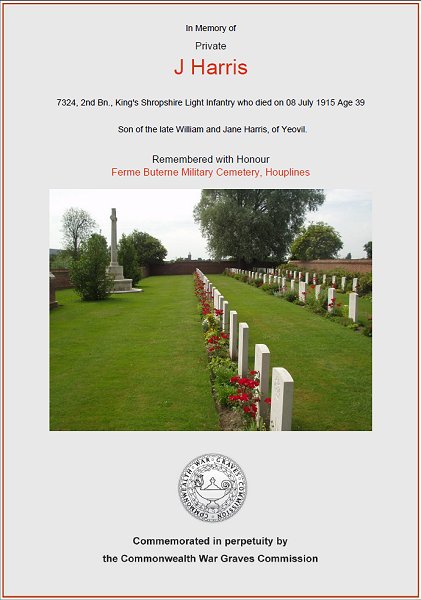yeovil at War
john william harris
Killed in France during the First World War
John William Harris was born in Yeovil in 1877, the son of leather dresser William Harris (1851-1891), originally from West Chinnock, and Jane née Thomas (1852-1885) originally from Cattistock, Dorset. In the 1881 census William and Jane were recorded living in one of the houses on the south side of Sherborne Road, opposite the Lyde Road junction, with their four children; Matilda (1871-1923), Florence (b1873), John William (1877-1915) and Albert (b 1880).
In the winter of 1885 John's mother, Jane, died in Yeovil and his father William died in the autumn of 1891. Following the death of his parents John went to live with his uncle, Albert Ostler, an agricultural labourer at Higher Lodge, East Coker. The 1891 census records 14-year old John was listed as a 'Farm Boy' living with Albert and Elizabeth Ostler and their two young children.
By 1901 John had moved again and the census found him lodging with Alfred Cratchley and his family next door to the British Oak pub in Ledbury, Hereford. John listed his occupation as a 'Labourer in a Skin Yard'.
In October 1911, at Leominster, Herefordshire, John married Margaret Williams, the daughter of Llewellyn and Emily Williams. John and Margaret were living in Hereford when he joined the army at Nuneaton.
 It
is not known
when John
actually joined
the army but it
is known that he
was a National
Reservist and
answered
the call to arms
at the outbreak
of the First
World War in
1914, he
was aged 38 at
the time. Since 1908
the British Army
had offered four
forms of
recruitment - as
a professional
soldier of the
Regular Army, a
part-time member
of the
Territorial
Force, as a
soldier of the
Special Reserve
as a soldier of
the National
Reserve.
Although there
had been long
debates about
conscription by
1914 this had
not come about
and Britain's
army was
entirely
voluntary.
Indeed
conscription was
only brought
into effect for
the first time
in the war after
the passing of
the Military
Service Act of
27 January 1916.
It
is not known
when John
actually joined
the army but it
is known that he
was a National
Reservist and
answered
the call to arms
at the outbreak
of the First
World War in
1914, he
was aged 38 at
the time. Since 1908
the British Army
had offered four
forms of
recruitment - as
a professional
soldier of the
Regular Army, a
part-time member
of the
Territorial
Force, as a
soldier of the
Special Reserve
as a soldier of
the National
Reserve.
Although there
had been long
debates about
conscription by
1914 this had
not come about
and Britain's
army was
entirely
voluntary.
Indeed
conscription was
only brought
into effect for
the first time
in the war after
the passing of
the Military
Service Act of
27 January 1916.
To join the army, a man had to pass certain physical tests and had to be willing to enlist for a number of years. The recruit had to be taller than 5 feet 3 inches and aged between 18 and 38 (so John, at his age, just 'squeezed in'). Each man had a choice over the regiment he was assigned and before the war would typically join the army for a period of 7 years full time service with the colours, to be followed by another 5 in the Army Reserve. However in August 1914 a new form of "short service" was introduced, under which a man could serve for "three years or the duration of the war, whichever the longer". Men joining on this basis, including all of "Kitchener's Army" and the "Pals" units, were technically of the Regular Army and were serving on this basis.
John chose to enlist in the King's Shropshire Light Infantry at Nuneaton and became No 7324, Private Harris of 2nd Battalion. The 2nd Battalion was a Regular battalion that had been serving in India from 1903 to 1914. It was at Secunderabad in August 1914 when mobilised for war. Consequently, we know that John joined the Regular Army rather than the Territorials or Reserves.
The ordinary "Tommy" began with basic training for physical fitness, drill, march discipline, essential field craft, and so on. Later he would receive specialised training, for example, as a rifleman, machine gunner, etc. If it was likely that his unit would be soon called to an active theatre of war, he would receive additional training in first aid, gas defence, and so forth, which continued when he was on active service.
The 2nd Battalion, King's Shropshire Light Infantry moved to Winchester and came under orders of 80th Brigade, 27th Division, and departed for France, landing at Le Havre on 21 December 1914, under the command of Lt. Col. Bridgford. Once the soldiers had arrived in France and were closer to the front, the more informal training at unit level and the often shocking experience of combat conditions meant that a man soon learned, or died. Training carried on intensively when a unit was out of the line. Not only was this necessary because there was a high turnover of men in any given unit, but the tactics and technologies of the war developed very rapidly. So-called 'assault training' was often a good indication to a unit that it was scheduled to be included in an offensive.
Although there is a tendency for most of us to imagine the First World War only in terms of life and death in the trenches, only a relatively small proportion of the army actually served there at any one time. The front-line trenches were, of course, the most dangerous places but most troops were employed to the rear of the front line trenches where there was a massive system of supply lines, stores, workshops, headquarters and so on. Consequently there was a system whereby front-line troops would usually be relieved on a regular basis to rest for a while in rear positions, to be replaced by rested troops from the rear.
Nevertheless, after some of the hardest fighting in the Ypres Salient at St Eloi, St Julien and on Frezenburg Ridge in the Second Battle of Ypres in the Spring of 1915, the battalion moved to the relatively quiet sector (at that stage) of the Somme. However on 8 July 1915 Private John Harris was killed when he was shot through the heart by a sniper just as he was leaving his trench. He was 39 years old.
He was buried in grave C1 at Ferme Buterne Military Cemetery, Houplines, Nord Pas de Calais, France.
His name was added to the War Memorial in the Borough in 2018.
gallery

I'm not sure which, but John Harris grew up with his family in one of the middle two houses in this terrace of six, at the eastern end of Sherborne Road.

The Commonwealth War Graves Commission certificate in memory of John Harris.

John Harris'
headstone.